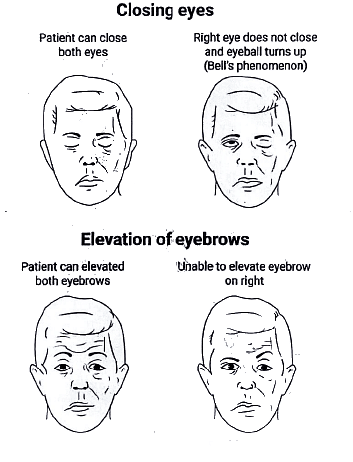Facial Nerve: Neuroanatomy | Medical Science Optional Notes for UPSC PDF Download
Facial Nerve

Origin
The facial nerve originates from two roots, motor and sensory, on the ventral aspect of the brainstem. It arises from the lower border of the pons, positioned opposite the groove between the olive and the inferior cerebellar peduncle.
Course and Distribution
- The primary trunk, or motor root, enters the external auditory meatus along with the small sensory root (nervous intermedius of Wrisberg), vestibulocochlear nerve, and labyrinthine vessels.
- At the lateral end of the meatus, the two roots join together to form the trunk of the facial canal. Initially, it courses above the bony labyrinth of the internal ear and then curves posteriorly along the medial wall, forming the genu of the facial nerve.
- Progressing posteriorly, it traverses the medial wall of the middle ear below the lateral semicircular canal.
- Ultimately, the nerve takes a 90º turn and follows the posterior wall of the middle ear until it reaches the stylomastoid foramen at its base, marking the point where it exits the cranial cavity.
- In its final course, the nerve runs anterolaterally to enter the parotid gland, where it subsequently branches into five terminal branches.
Branches
The greater petrosal nerve, joined by the deep petrosal nerve, forms the nerve of the pterygoid canal. This nerve supplies secretomotor function to the lacrimal, nasal, and palatal glands.
Nerve to the stapedius.
The chorda tympani nerve, which joins the lingual nerve, carries taste fibers from the anterior two-thirds of the tongue and provides preganglion fibers to the submandibular ganglion.
Posterior auricular nerve supplying the occipitalis and posterior auricular muscles.
Nerve to the posterior belly of the digastric and stylohyoid muscles.
Terminal branches for the muscles of facial expression:
a. Temporal
b. Zygomatic
c. Buccal
d. Mandibular
e. Cervical
Bells palsy
Bell's Palsy is characterized as an acute, peripheral facial paralysis or paresis of unknown origin. The patient experiences difficulty closing the eye, with the eyeball turning upward and outward (known as Bell's phenomenon). There is also noticeable drooling of saliva from the corner of the mouth, leading to facial asymmetry. Tears may stream down from the affected eye. Additionally, pain in the ear may precede or accompany the paralysis of the facial nerve.

 |
Download the notes
Facial Nerve: Neuroanatomy
|
Download as PDF |
Treatment

UMN vs LMN facial palsy
Upper Motor Neuron (UMN) innervation of the forehead is bilateral. The lower half receives contralateral innervation. In conditions like stroke, paralysis of the lower half of the face on the side contralateral to the lesion is observed. Conversely, in Bell's Palsy, paralysis of the lower half of the face is seen on the ipsilateral side.


Facial Nerve-Repeats
- Give an outline of anatomy of facial nerve mentioning its clinical significance (2007).
- Explain the origin and course of Facial Nerve. Describe its functional components and distribution. What is Bell’s palsy and give the anatomical reasons for the presenting signs? (2010)
- Enumerate the branches of facial nerve and write a brief note on Bell's palsy. (2014)
|
7 videos|219 docs
|
FAQs on Facial Nerve: Neuroanatomy - Medical Science Optional Notes for UPSC
| 1. What is the function of the facial nerve? |  |
| 2. How does the facial nerve innervate the muscles of facial expression? |  |
| 3. What are the possible causes of facial nerve paralysis? |  |
| 4. How can a facial nerve injury be diagnosed? |  |
| 5. What are the treatment options for facial nerve disorders? |  |


























